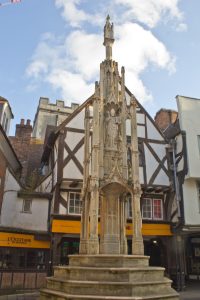
Buttercross
So called, because butter was sold there
There’s nothing like a break away to an historic city, and one I hadn’t been to at that (though Heather had, many years ago). So it was we found ourselves heading away for a week in August to the old capital of a kingdom, and Winchester.
Arrival
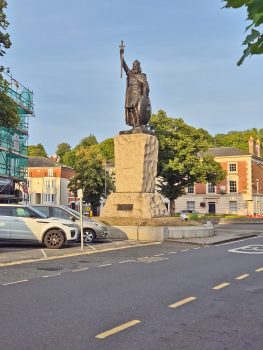
Alfred
The Great
Taking the train out of Waterloo we were soon enough arriving in the destination city. The first signs weren’t great, as there didn’t seem to be a pub immediately outside the station and we then found ourselves going up and over quite a steep hill to get into town. That annoyance quickly turned to delight though as the pretty town opened out ahead of us and we got a first look at its historic, interesting streets.
Having dumped luggage in the
The Bishop on the Bridge also disappointed us, but only by being too busy to get in. So we found our way to the Crown and Anchor with a nice little garden out the back.
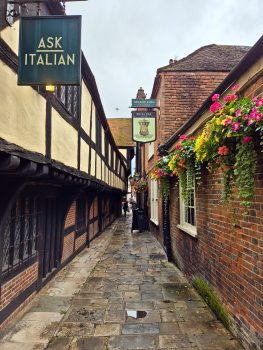
Old Alley
Down the old buildings, to the pub
We found our way back to the cathedral, which is large and impressive (we would get a closer view later), and, coming round, to the a nice little area of pubs, cafes and open spaces. We popped in to the Eclipse Inn, which turned out to have an old fashioned feel to it with a tiny front bar and quirky space to the rear (and apparently an upstairs space signposted only as the Ladies).
We continued up past the cross to the top of the hill, and then back round and down with the intention of eating in Ask. Unfortunately Heather had had dental surgery a little prior to our break, and this was still causing her difficulty in eating. A quick escape back to the hotel to control some bleeding was therefore needed. In the end we gave up ideas of anything fancier and headed to the Wetherspoons, which did a job but wasn’t exactly one of their better establishments, particularly on a Saturday night.
And so it was to bed, ready for an exciting trip out of the city we’d only just arrived in the next day
Trains

Dave
Honest. It’s Dave
We hopped out the hotel bright and early which meant we had a little time to investigate the little market we found occupying the High Street before standing around to catch a (inevitably late) bus out of town. That bus took us to Alresford (which seemed pretty enough from the brief glimpses we got) and a short walk to the Watercress Line heritage railway.
The smell and sound of steam engines are always a joy, and so we were very happy to be making a visit to a line I’d never been on before, and that Heather had last been on a couple of decades ago (we’d end up recreating a photo from that time). We were met by not a great beast but a little light blue tank engine called Dave (and definitely not called Thomas, or anything like that—the fact Thomas was visiting during the next week is purely coincidental and being called Dave is nothing to do with copyright…) Dave was standing in because the (much) larger Canadian Pacific had unfortunately had issues and wasn’t running.
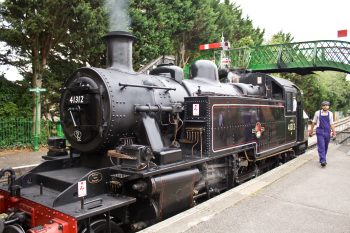
41312
A fine engine
We rode behind Dave all the way to the other end of the line at Alton and then back up to the intermediate station of Ropley where the line’s engine sheds are located. We had a good wander around, though there was a brief panic when Honey bear became separated having sneaked out of Heather’s backpack. She was quickly found though and we were able to catch the other running locomotive of the day back up to Alresford where the buffet was able to provide a slightly chaotic lunch (they ended up with two order numbers the same, and had to be chased for our coffee. Heather’s baked potato was really good though).
The trains had been enjoyable (and there are plenty of photos), though it’s probably not as good a line as say the Bluebell. We’d felt we’d “done” them though, so caught a bus back towards town, a journey made more memorable for the bus doing a complete circuit of a roundabout for no obvious reason.
Back in Winchester we wandered a little maker’s market in the impressive Guildhall before stopping off at the hotel. Dinner found us at the William Walker just round the corner, mainly because they’d feed Heather soup which was easy to eat.
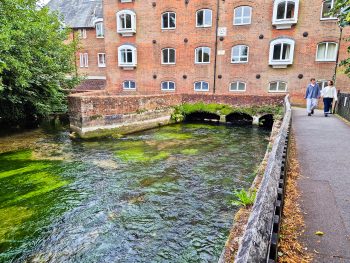
Mill Entrance
Modern flats on top of old mill
Fuelled we went for an evening stroll along the river, finding some ginormous rhubarb and the quirky Black Boy pub, which is full of a wild variety of miscellaneous items (it also does decent beer, and has a nice outside area to enjoy the evening).
We walked back and this time did manage to get into the Bishop on the Bridge, where we enjoyed its riverside seating well into the night before bed.
Tourism
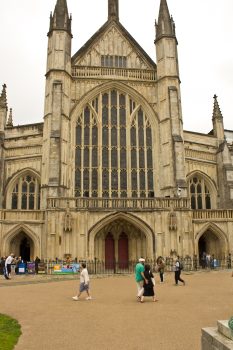
Cathedral Front
The great facade
Having not had that much time to explore when we arrived, or on Sunday thanks to playing with steam trains, Monday was our first real chance to do the touristy things one does in a place like Winchester. We started, logically enough, with a visit to the tourist information centre, and then headed for the towering attraction of the cathedral (we were going to go to the City Mill but found it closed till Thursday so it had to wait). The cathedral is certainly large. Indeed there are times when one has wandered round what feels to be a whole cathedral only to discover more of it. There are a couple of interesting points too—some colourful decoration giving a feel of what some churches would have been like, and rare wall paintings which are now hidden behind a cover depicting said painting, which makes one wonder at the point. The mortuary chests balanced around the screen of the choir are also interesting. A space marks the shrine of St Swithin (he of forty days of rain fame). Up stairs there’s an interesting “Kings and Scribes” exhibition, with a twelfth century bible.
Down in the crypt there’s an eerily silent space with an Antony Gormley sculpture. Sound II is a figure standing some distance from the viewer, inviting contemplation of both it and the larger surrounds.
To be honest though I found the exterior more interesting, giving a better sense of the architecture. The original church is marked out in the grounds, and one can see where the cathedral suffered subsidence at one end, almost collapsing before being rescued by diver William Walker—after whom the earlier visited pub is named, so we had another visit to honour him.
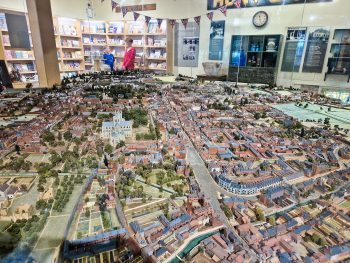
Model City
Big model of the city in the museum
Next on the tourist agenda was the City Museum which, to be honest, felt a little empty. Most city museums have a progression from the foundation of the city, through industrialisation, to the modern day. If Winchester’s is to be believed not a great deal happened since the Norman invasion. It does have a rather detailed town model though, which is interesting to look at.
Having explored the not so modern history of Winchester we went in search of a pub, finding what would become our fall back establishment (partly due to Heather’s tooth), in the Royal Oak, who’s menu would prove to offer enough tooth friendly variation for us to return several times.

Coffins
Of stone
We left after our first visit to drop into the hotel, where we found the lifts out of order and reception completely unhelpful in booking late check out—more to come. From there we had a wander around the pretty Abbey Gardens, finding the remains of the nunnery (the thing once gloried in the term Nunaminster) and then went back to the Royal Oak for dinner.
It was on our further return to the hotel that things came to a head, with both lifts still out of order (despite reassurances that maintenance were on there way), and an increasingly obstructive reception we went and checked in the hotel over the road—the first time I’ve ever found a hotel so annoying that I’ve went somewhere else, and I’ve stayed in some annoying ones.
Wanderings
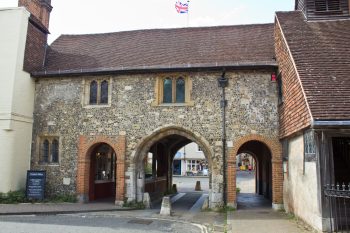
Kings Gate
With the church on top
By we were getting into the swing of sightseeing and headed off to explore some more. We started off by heading round what we were thinking of as the back of the cathedral, past high walls, to not one but two gates. The first of these, Kingsgate, was an entrance through the medieval wall. It’s made more curious by the charming little church sitting atop of it. We ventured up the almost afterthought of a staircase to explore the interior of St Swithun-upon-Kingsgate, a nice, quiet space.
The other gate is Prior’s Gate, forming an entrance to the cathedral and leading to the wonderful fifteenth century Cheyney Court, which appears suddenly like a dream of the past. Beside the court sits the Pilgrim’s School which now incorporates the Pilgrim’s Hall, once a guest house for the priory which preceded the cathedral. Looking at it now reminds one of the school house of Shakespeare in Stratford.
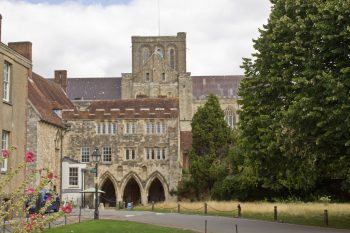
Cathedral From The Close
With the Deanery in the foreground
Beyond the court and school the cathedral looms with the deanery between. Delightfully the deanery now hosts a second hand book shop, which we couldn’t resist having a browse around, after having stopped at the cathedral itself for lunch (and Heather discovering their wonderful mac and cheese).
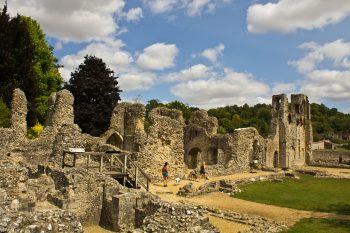
A Castle Feel
You can see how the palace was fortified
Back out through the Prior’s Gate and round, passing what may or may not be the house in which Jane Austen died There’s some debate if it’s the house still standing with a plaque, or one that stood on the other side of the road. We were heading for Wolvesey Castle. The castle wasn’t so much built as one, but in fact was the old Bishop’s Palace, dating mainly to the twelfth century when the Bishops of Winchester were powerful men in the country’s second city. Unfortunately Bishop Henry of Blois got caught up in the Anarchy (he was bound to given his brother was on one side, though at some point Henry also managed to support Matilda), and after it was all sorted out saw his position as precarious enough to fortify the palace into something closer to a castle.
Today the castle/palace is ruinous, making it quite hard to picture its past splendour. There are some interesting parts. The great tower raised by Henry can be made out, as can the kitchen. And there’s a latrine block with obvious drainage channels. Less clear is what was once a well and water network.
We left the castle behind to find a much deserved rest in The Wykeham Arms just outside the Kingsgate. Refreshed a stroll further along the road brought us to the impressive gates of part of the very up market Winchester College and the quiet little medieval St Michael’s Church (which it turns out is now the chapel to said college).
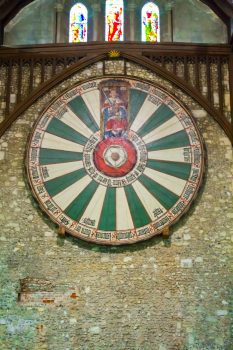
The Round Table
The most famous feature
That was as far out that way as we cared to explore though, so after a stop off at the hotel it was back through town to one of Winchester’s most famous attractions (or, at least, the building containing one of its most famous). The Great Hall is more or less all that remains of the once great Winchester Castle—there’s actually the base of a round tower still outside, the passages of which through which one can walk. The hall today sits strangely, surrounded by more modern development, including the adjacent court which took over its legal role in the mid-twentieth century, and two which two incongruous doors pass internally.
The hall is a large, open space, a double cube in size. The main attraction is the infamous round table, purported to be that of King Arthur (but, obviously not), which hangs on one wall (actually the opposite wall to it used to, thanks to that access to the adjacent courts). It’s slightly underwhelming, partly because its hanging high up on a wall and tricky to see. There’s actually not a lot else to look at in the hall, a few scattered boards about its history, a little model, but mainly empty space. Out the far side is a lovely little garden which seemed the best feature in honesty.
We left the hall and crossed the road (eventually—tricky junction!) to the appropriately named Westgate pub and after a couple of drinks back down to the hotel. The Royal Oak once again provided Heather friendly dinner before a call into the Bishop. We were tired out though, so retired early to an online talk and bed.
Travels
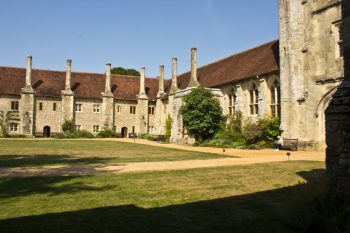
Alms Corner
Houses leading to the hall
As mentioned Heather had some memories of being in this part of the world before. One of those was a trip to the Hospital of St Cross, a twelfth century institution formed to support thirteen poor men—making it possibly England’s oldest charitable institution. Heather really wanted to revisit, which meant that we found ourselves hunting for another bus for the short journey slightly out of town to the Winchester suburb. There the quiet hospital and alms houses appear like some mysterious time warp, the busy road and housing fading behind its walls while fields and a hill once site of a hill fort on the other side.
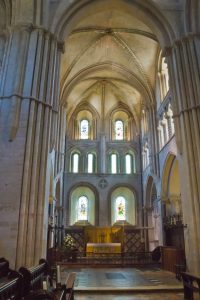
Church
It’s very large for where it is
We had brunch at the tea rooms (housed in the hundred men’s hall—so called because once the hospital would have fed “a hundred” poor; indeed any traveller may still demand their dole) sitting in the sunny outer courtyard. Then it was through the impressive gateway into the inner sanctum of green and fifteenth century alms houses. The alms houses themselves are a pleasing view, a regiment of chimneys standing tall above pleasant looking housing.
At the far end of the green stands a church, large enough to be cathedral like. We explored, and I got in trouble for making Heather laugh while a service was going on. From there we investigated the old hall and kitchens before heading out the institution to the nearby Bell pub, enjoying the continuing glorious sunshine.
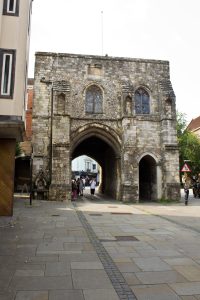
Inside The Westgate
Looking out of town
It was then a bus back to town, and lunch outside Cafe Monde before a walk up to the Westgate. The Westgate is the most prominent survivor of the city walls, a medieval gate reminiscent of the bars of York, with passage way through beneath. It contains a small, slightly cramped museum, with some decent views down the road to town from its roof. The museum wasn’t that interesting, though we did enjoy wandering around finding the centuries old carved graffiti around the walls.
Across the road we revisited the Westgate’s namesake pub before heading for a rest in the hotel before thinking about dinner. That found us wandering down Bishop again and then down the river to the Willow Tree. We didn’t fancy it’s menu though so ended up walking back into town to old friend the Royal Oak. We did end up heading back again for a nightcap in the Willow Tree‘s garden though.
Home Time
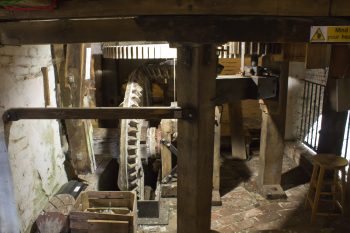
Cogs
The mill turning mechanism
Leaving the bags at the (second, better) hotel we returned to what had disappointed our intentions earlier in the week, the City Mill now being open. There’s a cafe inside which provided refreshment, though to be honest, not a great deal else—it feels like a missed opportunity. We wandered around the little garden area they have outside by the river (where we got our ducks in a row!). It’s also possible to go down below the mill building to where the paddle wheel is housed, though this sadly was out of action. The roar of the water passing through the run still gives a sense of power though.
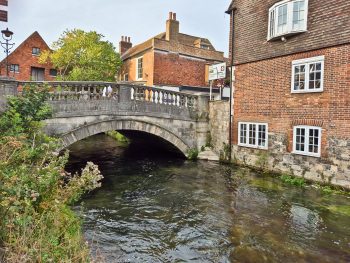
Pretty Bridge
Over the Itchen
Having finally seen the mill we followed the river, with pauses to play Poo sticks from its footbridges, back to the Willow Tree, where we got the chance to enjoy the garden in daylight. We came back and found lunch in the Crown And Anchor before heading for the cathedral again so Heather could find the bits she’d apparently missed first time round. I didn’t go in with her, but wandered round the back, taking a closer look at the still evident subsidence.
And then it was time to collect the bags and head home (just in time, as the station was busy with arrivals for a festival happening nearby). At Waterloo we called in the Victory to wait out the worst of rush hour, and then Wetherspoons at home provided dinner to round out an enjoyable break to a lovely city.
There were of course quite a few more photographs taken.
Comments and Pings